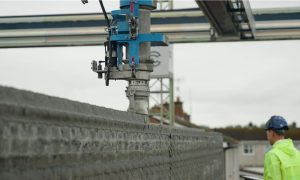Manitowoc crawlers on giant LNG plant
$1.25bn LNG terminal to be largest in Europe

Manitowoc crawler cranes are playing a key role in the construction of a $1.25 billion (€1bn) liquefied natural gas (LNG) terminal in Dunkirk, France, which when completed will be the largest LNG terminal in Europe.
The cranes are working up to 24 hours a day in a difficult coastal environment to complete the ambitious project on time. Owned by Dutch crane specialist, Crane House, the crawlers have lift capacities from 250t to 400t.
Crane House chose five Manitowoc crawler cranes to work on the project, with the first arriving in 2011. A Manitowoc 16000 and a Manitowoc 2250 were used for six months in the initial phase of the development to install underwater foundations and build a floating flat barge.
As the project entered phase two in August 2013, another Manitowoc 16000 was sent to the job site. The project manager was so impressed with the performance and reliability of this crane, that two more Manitowoc crawlers joined the project, a 2250 and 15000.
Most of the Manitowoc cranes work along the shoreline of the project but one was assembled on an off-shore platform, providing better lift capacity over the waterfront area of the project. While this third crane presented a more challenging assembly, a team of five engineers from Crane House assembled the three Manitowoc cranes in just three days.
Most recently, the Manitowoc crawler cranes built the terminal jetty, for which they primarily poured concrete using specially designed concrete buckets. They have been working double and triple shifts, often lifting continuously for days.
The 272 t capacity Manitowoc 2250 travelled from Libya to work at the LNG site and it was recently removed from the project to work at an off-shore jobsite near Casablanca, Morocco.
The LNG project, which is being delivered by a consortium led by Vinci, the world’s largest contractor, is due to complete at the end of 2015. Two Manitowoc crawler cranes remain working at the job site, which is among the largest construction sites under development in France.
The LNG terminal in Dunkirk will have the capacity to hold 13 billion m3 of gas – equivalent to 20% of France and Belgium’s annual natural gas consumption. Once complete, the site will consist of three LNG storage tanks, as well as marine structures and buildings providing connections to French and Belgian gas transmission networks.























